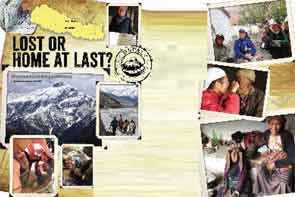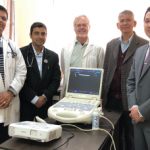
Sustainability Through Kunga
Each evening in a new tea-house room, Kunga and I saw villagers, who lined up outside after word got out. During the month, I saw 53 villagers, and the most common complaint was back pain. Forehead yokes keep the heavy loads fairly well aligned to protect lumbar discs, but straight-legged, flexed posture while working the fields is perfect for disc compression and herniation. I drew pictures and demonstrated lordotic posture and taught Williams extension exercises. In Samdzong, under the midday sun, I held the first back-pain prevention class, to the amusement of many. Kunga wrote excellent histories in my log and did rudimentary exams, and I taught him lung, abdominal, back, and joint examination. For osteoarthritis of the knee, I gave two intraarticular steroid shots and distributed small bags of low-dose ibuprofen, acetaminophen, and topical creams. Several men with chronic gastritis were treated for H. pylori, and another with hematochezia was treated for amebic colitis. One man with possible reactivation tuberculosis was sent to Pohkara. I asked him to wear a mask all day, which he did, and I am happy to report that I did not convert my purified protein derivative skin test.
Teaching Kunga allowed me to leave something sustainable behind. Differential diagnosis and targeted treatment is different from the traditional medicine instruction he received growing up (which was Sowa-Rigpa, similar to Ayurveda). In Tibetan medicine, illness is due to imbalance in the five basic elements, and medicinal herbs, diet, activity, and mantras are used to rebalance and treat most illness.2 When I asked, a young amchi (a traditional Tibetan medicine practitioner), Lhundup Bista, opined that at least 40% of illness was due to imbalance in the emotional/spiritual domains. His father, Amchi Gysato Bista, said it was difficult to treat osteoarthritis of the knee, but that his diet therapies did well in treating polyarthritis in younger patients, similar to the results of Ayurvedic medicine in treating rheumatoid arthritis.3
Ancestral bones from the caves showed evidence of vertebral compression fractures, erosive shoulder arthritis, and Achilles calcifications. The presence of mechanical back pain, inflammatory arthritis and enthesitis, osteoporosis, and emotional distress suggests rheumatology illness in the Upper Mustang may not be that different from that in Seattle.
Kunga is planning on getting a Master’s in public health, and is committed to the healthcare of the Mustang. While there is one doctor for every 850 people in the Kathmandu valley, rural areas have one doctor for every 150,000 people, and infant mortality more than doubles to 13.2%.4 I left Kunga medical books, instruments and supplies, and exam notes. We have e-mailed since my return, and I just know he will make a difference!
